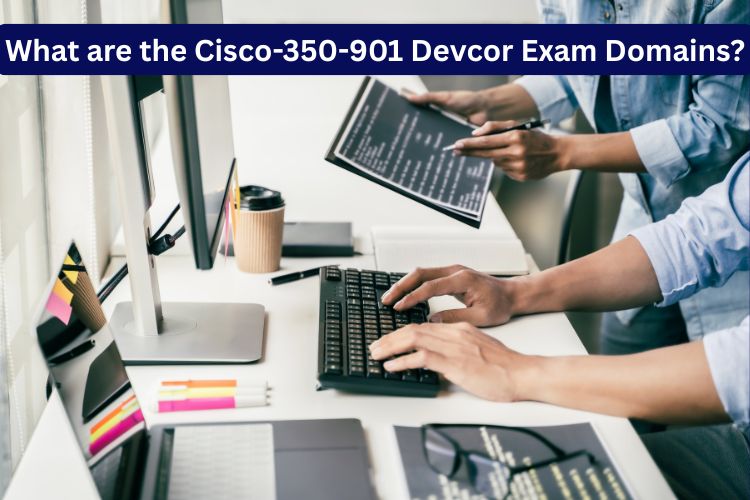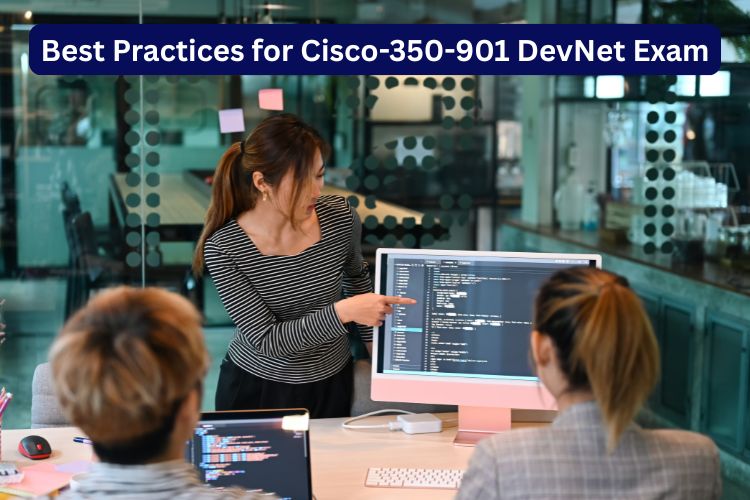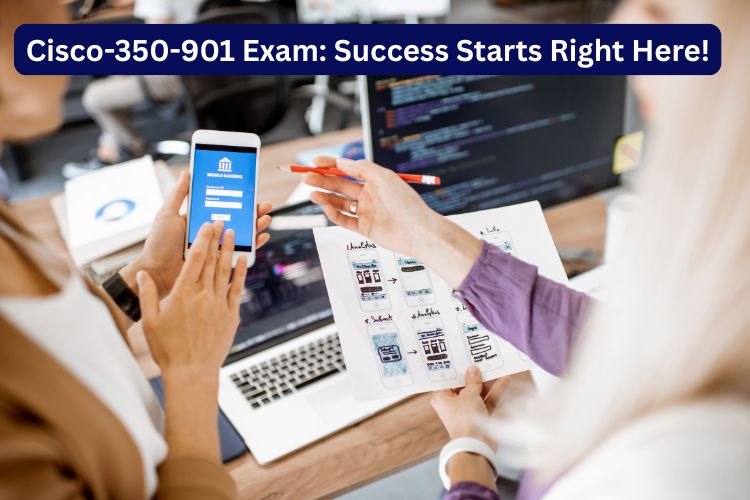Security, software development, automation, and cloud activities are all becoming more and more intertwined with networking. Many network practitioners now see the value of expanding their knowledge in fields outside of their conventional areas of specialization as a result of this shift.
Network professionals can become familiar with concepts such as cloud applications, programmability, APIs, and continuous integration and delivery (CI/CD) through the Cisco-350-901 DevNet certification track. They can also learn how to apply these concepts to their everyday network administrator tasks. The DevNet track provides many levels according to years of experience and subject-matter competence, just like Cisco’s other certifications. DevNet Associate, DevNet Specialist, DevNet Professional, and DevNet Expert are the four courses.
Understanding the significance of the study guide and curriculum of the Cisco-350-901 certification exam is a wonderful place to start while preparing for the Cisco Certified DevNet Professional (DEVCOR) test. This study guide serves as a tool to help you align with Cisco and comprehend the structure of the Cisco-350-901 DevNet Professional test.
In order to help you evaluate your preparedness for the Cisco-350-901 DEVCOR exam by identifying necessary knowledge areas, our team of experts has created this Cisco-350-901 exam preparation guide, which includes an overview of the Developing Applications Using Cisco Core Services and APIs exam, study materials, sample questions, practice exam, and methods to interpret the 350-901 -Training & Certifications objectives.
Keep exploring to learn how you can gain success in the Cisco-350-901 exam using our premium Cisco-350-901 exam dumps.
What are Cisco Core Platforms?
Cisco core platforms, which include a range of technologies and services, serve as the cornerstone upon which network applications are constructed. These platforms give customers access to Cisco’s development tools and APIs for designing, implementing, and automating network solutions. Enterprise networking, security, cloud and data center networking, and service provider networking are important domains.
What is the Cisco-350-901 Devcor Exam?

The Cisco-350-901 DevNet Professional certification consists of a required core exam and one specialized concentration exam. This combination is excellent because it demonstrates that you have both foundational knowledge and a focus in a particular field.
The core exam (Cisco-350-901 DEVCOR) assesses your skills in the following areas: software development practices and tools, API design and execution, app security, infrastructure as code, and some automation. The Cisco-350-901 exam consists of multiple-choice, drag-and-drop, and modeling questions that mimic real-world situations; you have 120 minutes to finish all of the questions, so time management is crucial. Cisco does not specify the exact passing score, and it varies between Cisco-350-901 exam versions.
To pass 350-901 -Training & Certifications, you must possess practical expertise. You might have to examine code samples, search for security flaws, or determine which API call is appropriate for a given activity. It is imperative that you practice with real-world examples prior to the Cisco-350-901 test in order to avoid being irritated and stuck on a question.
What are the Cisco-350-901 Devcor Exam Domains?

Here are the Cisco-350-901 exam domains you must know before getting our Cisco-350-901 exam dumps:
-
Software development and design – 20%
- Explain distributed applications using the terms load balancing, frontend, and backend.
- Examine an application design with modularity and scalability in mind.
- Consider high availability and resilience when evaluating an application design (including cloud, hybrid, and on-premises).
- Examine an application’s design with rate restriction and latency in mind.
- Take maintainability into account while assessing an application’s implementation and architecture.
- Take observability into account when assessing an application’s implementation and design.
- Examine issues with an application using event-related logs
- Consider application needs when choosing database types (e.g., relational, document, chart, columnar, and time series).
- Describe the event-driven, services-oriented, microservices, and monolithic architectural patterns.
- Use Git’s sophisticated version control features.
- Combine a branch
- Handle disagreements
- Git reset
- Git checkout
- Git revert
- Describe the ideas of dependence and release packaging.
- Create a sequence diagram with API calls in it.
-
Using APIs – 20%
- Put in place reliable REST API error handling for rate restrictions and timeouts.
- Put consumer code control flow for unrecoverable REST API faults into place.
- Determine how to use HTTP cache controls to optimize API consumption.
- Create an application that uses a pagination-compatible REST API.
- Explain the procedures in the grant flow for the OAuth2 three-legged authorization code.
-
Cisco Platforms – 20%
- Create API calls to use the Webex API for chatops implementation.
- Use Firepower device management (FDM) to construct API calls for object creation and deletion.
- To complete these activities, create API queries utilizing the Meraki platform.
- To enable an SSID, use the Meraki Dashboard APIs.
- To obtain location data, utilize Meraki location APIs.
- Create API requests to get Intersight data.
- Using a template, create a Python script that uses the UCS APIs to provision a new UCS server.
- Create a Python script to obtain and show wireless health data using the Cisco DNA Center APIs.
- Explain AppDynamics’ capabilities for instrumenting an application.
- Explain how to create a personalized dashboard that displays information gathered from Cisco APIs.
-
Security and Application Deployment – 20%
- Identify a problem in the CI/CD pipeline (e.g., missing dependencies, conflicting component versions, and failed tests).
- Use Docker and Kubernetes to integrate an application into a pre-built CD environment.
- Explain the advantages of static code analysis and continuous testing in a CI pipeline.
- Containerize an application using Docker
- Explain the “12-factor app”‘s principles.
- Explain a successful application logging technique.
- Describe data privacy issues pertaining to data transfer and storage.
- Determine which secret storage strategy is appropriate for a particular situation.
- Set up SSL certificates for particular applications.
- Put OWASP threat mitigation techniques into practice (such as XSS, The Cross-Site Request, and SQL injection)
- Explain the application of end-to-end encryption concepts to APIs.
-
Automation and Infrastructure 20%
- Describe the model-driven telemetry considerations, such as data storage and consumption.
- To set up a network device, including interfaces, static routes, and VLANs (IOS XE only), use RESTCONF.
- Create a procedure to set up network settings using:
- The Ansible playbook
- Terraform
- To meet technical and business objectives, choose a configuration management solution.
- Explain how to run an application on a network device, such as one that is Cisco IOx-enabled or Catalyst 9000.
Best Practices for Cisco-350-901 DevNet Exam

A clever study strategy, a lot of effort, and perseverance are required to pass the core and focus Cisco-350-901 examinations. The following advice will help you make the most of your study time.
-
Establish a Methodical Study Schedule
Determine the Cisco-350-901 exam subjects and allot study time according to the importance of each topic. Plan several short study sessions rather than packing them in too close to the deadline; treat this like a marathon rather than a sprint. Large quantities of Cisco-350-901 exam work may be divided into smaller, easier-to-manage chunks with the use of a study plan.
-
Make Use of Active Labs
While theory plays a role in the Cisco-350-901 exam, reading about APIs and automation won’t suffice. Practice, practice, practice is essential. Establish a laboratory setting if you can so that you can:
- Create Python programs to perform things automatically.
- Use Postman to make API calls to actual Cisco devices.
- Use Docker to create and launch containers.
- Build infrastructure as code releases.
You will struggle on the Cisco-350-901 exam day if you comprehend the material but are unable to put it into practice. Putting the theory into practice will be aided by carrying out the real work in labs.
-
Exam Topics and Blueprints Review
Cisco releases exam blueprints with broad instructions and explanations. Continue going over the Cisco-350-901 exam blueprint frequently to ensure that you have covered all the material required to ace the Cisco-350-901 exam.
-
Make Use of Online Communities
GitHub groups built on network automation subjects, DevNet community events, and the 350-901 -Training & Certifications are some excellent starting points. Online forums may respond to your inquiries, offer guidance on Cisco-350-901 exam study materials, and motivate you to continue learning and polishing your skills.
-
Regularly Assess Your Knowledge
Although it may be tempting to wait until the very end to assess your progress, you should make an effort to analyze how well you retained the material during your study. Get used to the exam style and use Cisco-350-901 exam practice tests to identify knowledge and ability deficiencies early.
Is It Worth It to Become a Cisco-350-901 DevNet Professional?
It is for the majority of IT workers. There is significant value in the DevNet Professional Cisco-350-901 certification:
- Improved Employment Opportunities: More businesses want network engineers with the ability to automate and create solutions for their networks.
- Greater Salary Potential: Compared to typical network engineers, network professionals with automation abilities may make 15–25% more.
- Relevant talents: Technical interviews may require you to work on test systems to demonstrate your practical talents, which is why the certification emphasizes skills you’ll really utilize.
- Profession Advancement: These abilities can help you future-proof your profession as networks become increasingly software-defined.
Cisco-350-901 DevNet Professional Exam Sample Questions and Answers
Now is the time we discuss the main Cisco-350-901 exam dumps sample questions before you buy it from our website.
Question 1:
Based on the needs of the client, a developer has produced an application. The program must be used by the client with the least amount of downtime.
Which design strategy should be used for high-availability applications in terms of Recovery Time Objective, Recovery Point Objective, and Recovery Time Objective?
- Lower RTO and RPO are the effects of active/passive. For RPO to function well, rapid data synchronization between the two data centers is required.
- Lower RTO and RPO are the outcome of active/passive. RPO does not need quick data synchronization between the two data centers in order to facilitate smooth request flow.
- Lower RTO and RPO are the outcome of active/active. RPO does not need quick data synchronization between the two data centers in order to facilitate smooth request flow.
- Lower RTO and RPO are the outcome of active/active. For RPO to function well, rapid data synchronization between the two data centers is required.
Question 2:
Which two load-balancing strategies maximize the user experience of an application that has both a simple search feature and a video upload function? Select two.
- An intermediary hop should be used to redirect video upload requests to the destination.
- The endpoint with the lowest round-trip latency should receive search queries.
- The endpoint with the lowest round-trip latency should get requests for video uploads.
- The endpoint with the greatest data throughput should receive requests for video uploads.
- The endpoint with the highest data throughput should receive search queries.
Question 3:
A big cloud-deployed application using a microservices architecture is managed by an organization. Because this application’s services are redundantly deployed across three or more data center regions, there are no noticeable downtime concerns. Nonetheless, complaints regarding application lag are received many times each week. Faults in various containers as a result of them to, fail and then spinning up again are seen in the container orchestration logs.
What steps need to be performed to keep the application’s existing scale while improving its resiliency design?
- Update the containers’ base image.
- Use a different cloud service platform to test how the application runs.
- Boost the number of containers operating for each service.
- Make sure the code has consistent {^€try/catch(exception){�€ clauses.
Question 4:
The logging dashboard is showing these notifications, and users claim that they are no longer able to execute transactions using the online ordering application.
Fri., January 10, 2020, 19:37:31.123 EST [FRONTEND] INFO: User 45834534858 has requested to add an item to their cart.
Fri., January 10, 2020, 19:37:31.247 EST [BACKEND] INFO: Trying to put anything in the cart
Friday, January 10, 2020, 19:37:31.250 EST [BACKEND] ERROR: The item was not added. MySQL and MySQL Database ERROR: No connection was made.
What’s causing the issue that these log messages show?
- The container for the database server has crashed.
- There are too many transactions overloading the backend process.
- The database cannot be committed to by the backend.
- Adding the item to the user’s cart is not permitted.
Question 5:
A company oversees a sizable cloud-deployed application that uses several data centers and a microservices architecture. There have been complaints regarding the speed of the application. Faults have been reported in a number of containers, causing them to fail and then spin up new instances, according to the container orchestration logs.
Which two steps may be taken to enhance the application’s design and find its flaws? Select two.
- Automatically remove the container that experiences the most failures over time.
- Put in place a tagging technique that tracks how an application is executed across services.
- Include an exception for logging on and give prompt notice.
- In the event that an application fails, write to the datastore.
- Put in place an alert-equipped SNMP logging system in case a network link is sluggish.
Conclusion
The DevNet Professional Certification is achieved through the completion of the 120-minute Developing Applications using Cisco-350-901 Core Platforms and APIs (DEVCOR ) exam. This test verifies a candidate’s proficiency with Cisco platforms, APIs, application deployment and security, infrastructure, and automation, among other aspects of software development and design. Candidates might better prepare for this test by taking the Developing Applications with Cisco Core Platforms and APIs course.
FAQs (Frequently Asked Questions)
This Cisco-350-901 Certified Devnet Professional Course Is Appropriate For Whom?
The main target audience for this Cisco Certified DevNet Professional program is often software developers, network engineers, and solutions architects.
Does This DEVCOR 350-901 Course Lead To Any Certifications?
Indeed, the learning targets on Cisco’s Certified DevNet Professional certification test are aligned with the training’s unique architecture. In order to become a DevNet Professional, you must pass two tests: a core exam that everyone takes and a concentration Cisco-350-901 exam of your choosing. This course helps you prepare for the core exam.
What Kind Of Certification Should You Think About After Completing DEVCOR Cisco-350-901?
After completion, you’ll most likely wish to become a Cisco DevNet Professional. Only the core is covered in this program, and there are two tests.

